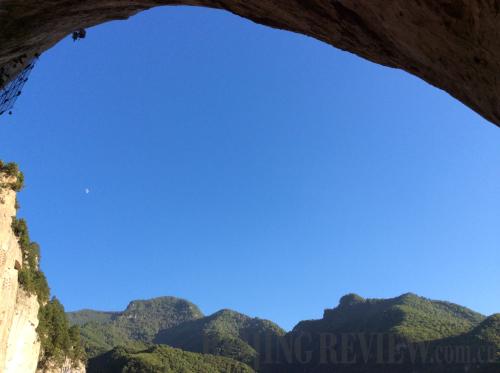|
 |
|
NATURAL WONDER: From the vantage point of a huge cave on the south slope of Mianshan, hills across the valley take the form of a reclining Buddha (DING YING) |
"Mianshan is one of the six famous Shanxi scenic spots first approved in 1987," recalled Wu Chunlin, a local tourism official. "At that time, Mianshan was merely a huge mountain with several old temples scattered across it. It wasn't until 1993 that the mountain started to be developed as a tourist site."
That year, a fire burned through part of the 1,500-year-old Yunfeng Temple. The Jiexiu City Government was so financially strained that it had to seek support from local entrepreneurs in a bid to repair the temple. Yan Jiying, Chairman of the Board of the Shanxi Sanjia Group, volunteered to help, donating 300,000 yuan ($60,000 at that time).
Born in a village near Mianshan, he borrowed 700 yuan (then $350) in 1983 to start his business. One decade later, he became the richest man in Jiexiu and his company employed over 6,000 workers. To his town fellows, Yan is not only a successful businessman, but also a good Samaritan due to his generous contributions.
At first, Yan's decision to help develop Mianshan was firmly refused by other members of the company's board, as the cost of restoring such a huge mountain would require an abyss of money. But Yan convinced them by saying he felt a need to repay the natural environment that his industry was polluting.
Due to the steepness of the cliffs and the high altitude, Yan's donation, which was then a large amount of money, covered only the expenses of repairing the temple's main hall. The local government then signed a contract with Yan's company on the development of Mianshan over the next 50 years, so that it could continue to invest in the project.
"In the mid-1990s, we were facing problems with industrial upgrading and environmental protection. The development of Mianshan was part of our overall upgrading plan," said Wu. "Now, the project has succeeded."
To date, the development of Mianshan has cost over 3 billion yuan ($488 million). About 25 square km has been revamped, including over 360 scenic vantage points. On May 1, 2000, the tourist site was opened to the public. Now about 10 million tourists visit the area each year, bringing in an annual income of more than 300 million yuan ($48.8 million). In the meantime, Yan's company has switched its main business from producing coke from coal to organosilicon chemistry, an industry that better meets environmental protection standards.
Zhi Shijun, Publicity Manager of Yan's group, noted that today's Mianshan largely attracts tourists in three categories: those seeking a cultural atmosphere, those interested in the mountain's religious history and those who want to enjoy its natural scenery. For example, due to the influence of Pure Land Buddhism in East Asia, many Buddhists from Japan and South Korea come to pay homage at temples on the mountain.
"Seeing the majestic scenery on Mianshan and experiencing the traditional culture, I felt an urge to leave the city behind and stay here to cleanse my spirit," said Wang Jin, a tourist from Beijing.
Zhi stressed that the development plan over the next five years will focus on ecological tourism, which will cost over 500 million yuan ($81.4 million). The projects include a natural mineral water plant and a millet wine plant, which are possible thanks to the well-protected water resources on Mianshan.
"The ecological development of Mianshan will reap benefits for posterity," said Du Guohua, Vice General Manager of the Shanxi Sanjia Group. He said that thanks to the last 20 years of continued ecological protection, large wild animals like musk deer and leopards have returned to Mianshan.
"In the past, people used to joke about Shanxi's air pollution problem, exaggeratedly saying that there were no white pigeons in the coal-rich province because of the amount of coal ash in the air. Now, it is our hope that we can work to change these conditions through our concerted efforts," said Du.
Email us at: dingying@bjreview.com | 